Volume 17 Issue 1
Latest articles
- Researchpp 1680-1689Zhao, C., Quan, W., and Ding, G. (2022). "SPME-GCMS combined AMDIS and KOVÁTS retention index to analyze the volatile organic compounds in Russula rubra (Krombh.) Bres. essential oil," BioResources 17(1), 1680-1689.AbstractArticlePDF
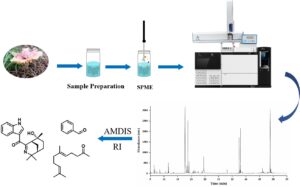
Volatile components in Russula rubra (Krombh.) Bres. were determined with the use of a solid-phase microextraction (SPME)/gas chromatography-mass spectrometry (GC-MS) method. The compounds were identified by the automatic mass spectral deconvolution and identification system (AMDIS) and Kováts retention index (RI). Under the optimized conditions of GC-MS, 52 volatile components were identified in Russula rubra, with the relative percentage accounting for 80.2% of the total ion peak. Notably, aristolone (20.4%), benzaldehyde (20.2%), geranyl acetone (11.0%), and 3-octanone (10.7%) were all at higher levels in samples. The main identified compounds were aldehydes, ketones, alcohols, ethers, and alkanes.
- Researchpp 1690-1702Dzurenda, L. (2022). "Range of color changes of beech wood in the steaming process," BioResources 17(1), 1690-1702.AbstractArticlePDF
Changes in color were evaluated for beech wood Fagus sylvatica L., caused by a steaming process using either a mixture of saturated steam and air or saturated water steam in the temperature range: t = 95 °C to 125 °C for a duration of T = 3 h to 12 h. The initially light white-gray color of beech wood with a yellow tint darkened during the thermal treatment process. It changed to a pale pink-brown and then to dark brown color. According to the visible changes in the color of beech wood obtained by the thermal treatment process with the human eye, , a color scale was proposed as a means to categorize the severity of treatment. The color ranged from a pale pink-brown color to a dark brown-red color depending on the value of the total color difference ∆E*.
- Researchpp 1703-1716Sözen, E. (2022). "Determination of changes in the mechanical and color properties of some wood species treated with shellac," BioResources 17(1), 1703-1716.AbstractArticlePDF
The properties of wood, which is a natural and sustainable substance, change under biotic and abiotic factors. Different methods along with chemical/natural substances are used to extend the service life of wood and increase its performance under different conditions. Shellac is a natural product secreted by insects onto host trees. It is used extensively as a coating, especially in the food and pharmaceutical industries. Its natural properties and biocompatibility increase the areas where it is used. This study investigated the effects on the physical and mechanical properties of pine, beech, and fir species impregnated with shellac solutions at different concentrations (1%, 3%, and 5%) and sodium hydroxide (NaOH). The study found that 10% NaOH solution caused significant decreases in the bending strength values. The highest bending strength values were obtained for the Scots pine and fir woods at 5% shellac concentration and for the beech wood at 1% concentration. The highest modulus of elasticity (MOE) values were reached at 1% shellac concentration in all three tree species. Although the lightness (L*) of the wood samples decreased with shellac impregnation, the chromatic coordinate (a* and b*) values increased. According to the Fourier-transform infrared (FTIR) spectroscopy results, changes were determined in the chemical structures of the wood samples impregnated with NaOH, whereas the shellac did not cause a change in the chemical structure of the wood samples.
- Researchpp 1717-1728Li, H., Dai, Y., Qiu, H., and He, X. (2022). "Application of multi-camera digital image correlation in the stability study of the long timber column with the circular cross-section under axial compression," BioResources 17(1), 1717-1728.AbstractArticlePDF
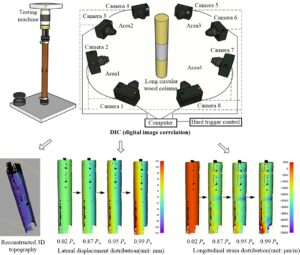
Displacement meter synthesis (DMS), as a traditional method, is widely used to capture the local deformation of a specimen. However, for axis-symmetrical circular columns, the axial compression instability cannot be accurately evaluated using the DMS method due to the uncertain bending direction. To address this problem, a 360° full-surface digital image correlation (DIC) system composed of eight cameras is proposed to capture the full-field deformation information of the column surfaces under axial compression. The objective of this study was to experimentally validate the efficiency of the proposed novel measurement in tracking the full-filled compressive deformation of a long wooden column with the circular cross-section. The test results showed that the columns experience instable failure. The multi-camera DIC system can completely reconstruct the three-dimensional shape of the circular column and obtain the whole process deformation state at any position on the surface of the timber column. The DIC method also can capture the uncertain lateral deformation direction and obtain the data of lateral deflection at the mid-span of timber columns. The multi-camera DIC provides an intuitive and comprehensive new test method for the test and analysis of the stability of axisymmetric long timber columns.
- Researchpp 1729-1744Ren, R., Zhong, Y., and Fan, Y. (2022). "A high-performance electrode based on reduced graphene oxide/lignosulfonate/carbon microspheres film for flexible supercapacitors," BioResources 17(1), 1729-1744.AbstractArticlePDF
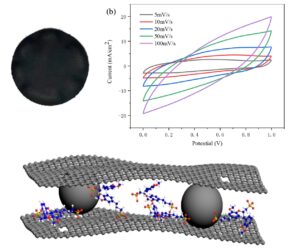
Reduced graphene oxide (RGO) flexible film pillared with lignosulfonate (LS) and carbon microspheres (CM) was fabricated via a facile vacuum-filtration process to serve as a high-performance electrode material for supercapacitors. Composite electrodes comprising graphene and biomass materials have the advantages of being flexible, lightweight, cheap, and environmentally friendly. The addition of LS and CM between the RGO layers mitigated the self-restacking of reduced graphene oxide flakes. Composite film electrode displayed a high specific capacitance of 641 mF cm-2 at 0.2 mA cm-2, which was much higher than that of the RGO film (117.9 mF cm-2). The present findings indicate a great potential of the graphene films composited with biomass materials in fabricating flexible supercapacitor electrodes.
- Researchpp 1745-1763Aydın, M. (2022). "Effects of annual ring number and width on ultrasonic waves in some softwood species," BioResources 17(1), 1745-1763.AbstractArticlePDF
The effect of annual ring number and width on the longitudinal (P) and transverse (S) ultrasonic wave velocities in the radial direction of black pine, Scots pine, Turkish red pine, and cedar softwoods was evaluated in this study. Annual rings were evaluated using high-resolution images captured with a Lumix camera. The 2.25 MHz P and 1 MHz S wave frequencies were propagated through the radial direction of small clear samples. An increase in ring number caused different changes in the P and S wave velocities. Only Scots pine and cedar presented continuous decreases in P and S wave velocities with the increase in annual rings. On the contrary, VR of Red pine slightly decreased and surpassed the initial value when the ring numbers increased from 5 to 10 and 15, respectively. Furthermore, the greatest decrease (4%) in the velocities was observed for VRL of Red pine. According to one-way ANOVA results, significant relations were only observed for VR vs. ring number of Black pine and cedar. R2 values ranged from 0.0001 (Red pine VR) to 0.18 (Cedar VR) for ring number and 0.0002 (Cedar VR) to 0.44 (Scots pine VR) for ring width. Furthermore, ANOVA results for linear regression analysis showed that VR of Scots pine and VR, VRL, VRT of Red pine can be statistically significantly predicted by the ring widths.
- Researchpp 1764-1780Wang, W., Yao, J., and Cao, X. (2022). "Alkaloids from tobacco leaves: Isolation, alkaloid contents, and potential application as a natural pesticide against Bactrocera dorsalis," BioResources 17(1), 1764-1780.AbstractArticlePDF

The essential oils from three different kinds of discarded tobacco leaves (flue-cured tobacco, burley tobacco, and sun-cured yellow tobacco) were extracted and isolated, and their isolation method, alkaloid contents, and potential application as a natural pesticide against Bactrocera dorsalis were investigated. The yields of the crude extracts were ranked as follows: sun-cured yellow tobacco was greater than flue-cured tobacco, which was greater than burley tobacco; all their alkaloid contents were analyzed via high performance liquid chromatography tandem mass spectrometry. The total contents of the 4 primary alkaloids (nicotine, anatabine, nornicotine, and anabasine) in the extracts were as follows: flue-cured tobacco (62.1%) was greater than sun-cured yellow tobacco (58.2%), which was greater than burley tobacco (50.7%). The insecticidal activities of the extracts against Bactrocera dorsalis were evaluated via the stomach poisoning method, and the results indicated that sex had no considerable effect on the activity. Surprisingly, the activity of burley tobacco, which contained the lowest nicotine content, showed the best toxicity against Bactrocera dorsalis.
- Researchpp 1781-1793Cao, J., Li, R., Qu, H., Wang, P., Fu, J., Chen, M., and Chen, Y. (2022). "Effects of the membrane-covered technology and superphosphate on the compost quality and nitrogen-containing gas emissions during aerobic composting," BioResources 17(1), 1781-1793.AbstractArticlePDF
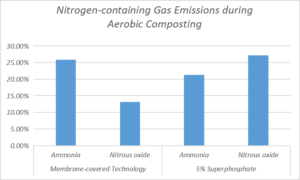
A lab-scale experiment was conducted to assess effects of the membrane-covered technology and superphosphate on the compost quality and emissions of nitrogen-containing gases during aerobic composting. The results showed that the membrane-covered technology increased the temperature of the compost pile and accelerated degradation of organic matter. The membrane-covered (T1) sample attained a germination index (GI) of 50% and 80%, approximately 2 and 9 d earlier, respectively, relative to the control (CK) sample. However, the application of superphosphate might have an adverse effect on the GI value. The NH3 and N2O emissions during the aerobic composting were decreased by 25.8% and 13.1%, respectively, for the T1 sample compared to the CK sample, while these were reduced correspondingly by 21.3% and 27.2% for the superphosphate addition (T2) sample. Compared with the superphosphate addition, the membrane-covered approach reduced the NH3 emission but not the N2O emission. Thus, the membrane-covered aerobic composting is a potential technology for the adequate utilization of organic waste as a resource.
- Researchpp 1794-1804Doczekalska, B., Bartkowiak, M., Łopatka, H., and Zborowska, M. (2022). "Activated carbon prepared from corn biomass by chemical activation with potassium hydroxide," BioResources 17(1), 1794-1804.AbstractArticlePDF
With the depletion of fossil fuel feedstocks, the lignocellulosic biomass, including the agro-wastes, can serve as the best alternative source to produce activated carbons (ACs). Corn biomass (corn leaves, stalks, cobs without kernels, silk, and kernels) were used to produce ACs in a two-step process. Crushed plant material was carbonized at 600 °C and then the obtained carbon was activated using potassium hydroxide at 750 °C. The content and type of surface oxygen functional groups were determined by the Boehm method and infrared spectroscopy. The porous structure of the obtained AC was determined by the nitrogen adsorption/desorption method at -196 °C, and the thermal resistance by the thermogravimetric method. The iodine number was also determined. The ACs derived from corn biomass were characterized with surfaces rich in chemical groups and revealed a highly developed porous structure. The specific BET surface area ranged from 1600 m2/g to 1965 m2/g. High values of iodine number approx. 1300 mg/g, indicated an extensive system of pores and their good adsorption properties.
- Researchpp 1805-1817Taheri, A. A., Rahmaninia, M., and Khosravani, A. (2022). "Interaction of the electrical conductivity of recycled pulp colloidal suspension with chitosan and bentonite as a papermaking additive system," BioResources 17(1), 1805-1817.AbstractArticlePDF
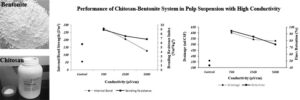
The performance of chitosan biopolymer-bentonite microparticle system in recycled pulp colloidal suspension of old corrugated containers with different electrical conductivities was considered. Various instrumental analyses (atomic force microscopy, field emission scanning electron microscopy, dynamic light scattering, and Fourier-transform infrared spectroscopy) were applied to characterize the applied chemicals. The results indicated that the mentioned system could increase the process and mechanical properties in comparison to the control sample. Although increasing the electrical conductivity of the recycled pulp decreased the performance of chitosan-bentonite system to some extent, the system was successful in its mission even at the highest electrical conductivity, i.e., increasing the retention, drainage, tensile index, tear index, bending strength and internal bonding strength, with improvement of approximately 41%, 32%, 8%, 16%, 26%, and 57% in comparison with the control samples, respectively. Therefore, this method can be a fascinating approach to the papermaking process. Moreover, the probable reasons of the mentioned achievements were considered and discussed.
